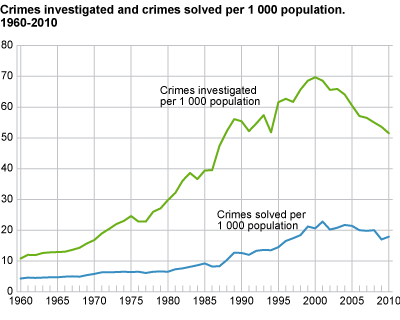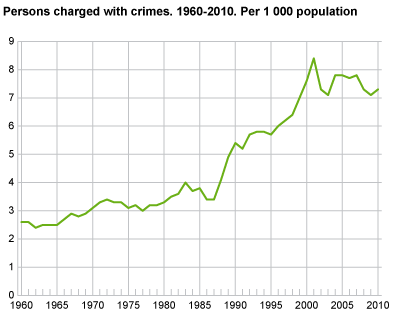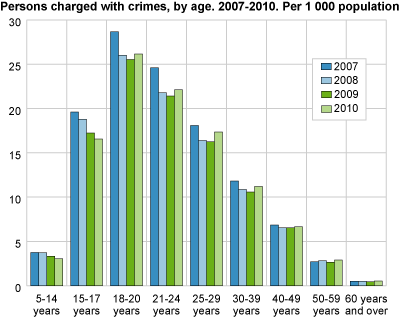Content
Published:
This is an archived release.
More charged with drug offences
Investigations were completed on almost 370 000 1 offences in 2010, of which more than 178 000 are regarded as solved. This resulted in 83 600 persons charged. Compared with previous years, the number of persons charged with drug offences has substantially increased in 2010.
The police and the prosecution authority completed the investigation of 253 500 crimes and 116 400 misdemeanours in 2010. The total share of investigated crimes was 3.8 per cent less than in 2009, and as much as 26.1 per cent less than in 2000, adjusted for the increase in population (see figure).
Compared with 2009, the number of completed investigations into drug offences increased by more than 13 per cent, and the number of offences in the category “Other offences” by almost 8 per cent. In absolute numbers, however, the reduction was greater for offences for profit and damage to property, which had a reduction of almost 6 per cent and more than 9 per cent respectively. Thus, there was a reduction for almost all specified types of larceny (for the reduction in larceny over several years, see Statistics on Offences reported to the police ).
More offences solved
Whether an offence is solved or not, and which legally binding decisions are made, vary substantially for the various groups of offences and types of offences. Drug crimes have the highest share, with 87 per cent, while offences for profit and damage to property have the lowest, with 22 and 19 per cent respectively. An increase in the number of solved drug crimes and larcenies, combined with a fall in reports of larcenies and damage to property that are traditionally not solved, led to the share of solved offences increasing from 46 per cent in 2009 to 48 per cent in 2010. For crimes, the share solved increased to 35 per cent, which is at the same level as the period 2004-2008.
More solved and even fewer unsolved larcenies
In recent years there has been a reduction in the number of larcenies solved. In 2010, however, there were more larcenies solved for almost all specified types, and the police and the prosecution authority solved a total of almost 8 per cent more larcenies in 2010 than in 2009. However, the 15 000 solved larcenies in 2010 is considerably fewer than in 2007 and the preceding 20 years.
In 2010, more than 114 000 larcenies were dismissed as unsolved, mostly due to a lack of information on the perpetrator. This is almost 9 800 fewer than the previous year, and together with the increase in the number of solved cases led to an increase in the total share of solved larcenies; from 10.1 per cent in 2009 to 11.6 per cent in 2010. For other common types of offences for profit, such as simple fraud and petty larceny, there was a fall in both the number of solved and unsolved cases.
More charged with crimes and fewer with misdemeanours
In 2010, police investigations resulted in 182 000 charges against 83 600 persons. A total of 35 900 persons were charged with one or more crimes, while the remaining 47 700 were charged solely with misdemeanours.
In absolute numbers, almost 5 per cent more were charged with crimes than in 2009. Adjusted for changes in the population, the increase is somewhat smaller, and on a par with 2008 (see figure). Compared with the previous year, somewhat fewer were charged solely with misdemeanours. This reduction is related to the 3.5 per cent reduction in the number charged with a traffic offence as their principal offence.
Further fall for those under 19
During the period 2007-2010, a steadily smaller share of the population under 19 years of age were charged with crimes. This trend was also prevalent from 2010 for the age groups up to 40. However, all age groups over the age of majority have a somewhat higher share of charged persons in 2010 than in 2009 (see figure).
Fewer charged with offences for profit and violent offences
A total of 18 400 persons were charged with one or more offences for profit in 2010. Almost 15 per cent of these were also charged with other offences that have a higher sentencing framework and are classed under another principal offence group. In other words, 15 700 persons had one case of larceny or another type of offence for profit as their principal offence. This is more than 3 per cent fewer than in 2009 and 15 per cent fewer than in 2004. The breakdown of charged persons into the more detailed types of crimes for profit varies somewhat from year to year, and the reduction between 2009 and 2010 was greatest for petty larceny, receiving stolen goods and simple fraud. However, there were just as many charged with larceny as the principal offence; either simple larceny or aggravated larceny.
In total, almost 9 000 persons had more than 13 300 charges against them for threats or other violent offences in 2010. Of these, almost 7 400 had one violent offence as their principal offence, which is somewhat fewer than the previous year and almost 5 per cent fewer than in 2007. This means that a violent offence was the principal offence for more than a fifth of all persons charged with crimes in 2010.
More, and a very high share, are charged with drug offences
The 12 200 persons charged with offences of narcotics as their principal offence is almost 14 per cent higher than in 2009. This is substantially higher than in all previous years for which statistics are available, and applies to both the scope of persons charged with violations of the Penal Code and those with less serious violations of the Act relating to medicines etc. In relative terms, the largest increase for those who were solely charged with drug use, and the 2 900 persons charged with this as their principal offence in 2010 was 22 per cent more than in 2009. Persons charged with drug offences as their principal offence therefore make up more than a third of all persons charged with crimes in 2010.
A total of 37 900 charges were brought for offences of narcotics in 2010, which constitutes 21 per cent of all charges for offences and 41 per cent of all charges for crimes. Almost 17 200 persons had one or more drug charges brought against them, and these therefore make up 48 per cent of all persons charged with crimes. The corresponding share in the age group 21-29 is 60 per cent.
No major increase in charges against foreign nationals
The total number of Norwegian citizens that were charged with offences in 2010 is the same as in 2009. After a considerable increase in the preceding year (see Investigated offences 2009 ), there was a somewhat more moderate increase from 2009 to 2010, of 6 per cent, in the number of foreign nationals charged. This is less than the general increase of foreign nationals in the population (ref. Population statistics ). The number of charged persons who are registered as a resident of another country is, however, higher than in previous years, and made up almost 7 per cent of all persons charged with crimes in 2010.
Eighty-two per cent of persons charged with a drug offence as their principal offence in 2010 were Norwegian citizens. This is around the same share as in 2009, and in absolute numbers, the increase of 1 150 more Norwegian citizens is the largest contributor to the total rise in this group.
Highest recidivism among young men
The statistics on recidivism among residents of Norway indicate that almost half of the more than 78 900 persons charged in 2005 were charged once or more during the subsequent five-year period. Classified by offence group, the highest rate of recidivism, with 66 per cent, was among those charged with drug crimes as their principle offence. The corresponding share among those charged with offences for profit and violent offences is 57 per cent, and 36 per cent among those charged with sexual offences.
Half of all men charged in 2005 were also charged during the subsequent five-year period, and in the age group 15-17, two out of three were repeat offenders. As in previous years, the share of repeat offenders falls substantially with age among men. Around one in every three women were repeat offenders, and the difference between the various age groups is much less pronounced among the women than the men.
1 The number was corrected, 14 June 2013.
New statistics, and figures in StatBank from the year 2010As from 2010, statistics will be published with the unit charges against persons , in addition to the two other principal units offences and charged persons , which are already included in the statistics. The statistics on charges contain a complete overview of all the offences that the charged persons are charged with during the course of the year. The police and the prosecution authority must have made a legally-binding decision against a specific perpetrator (prior to any prosecution and court trial) in order for Statistics Norway to define a charge and a charged person. A person suspected of having committed an offence may be given the legal status “charged” at various times during the investigation. Persons who have been charged during the investigation, but are not regarded as the perpetrator upon completion of the investigation, are not included in the statistics. Statistics Norway's definitions and use of the terms "charged person", “charge” and “charges” are not, therefore, synonymous with corresponding legal terms in Section 82 of the Criminal Procedure Act. Charges against enterprises are not included in the statistics on charges against persons or charged persons. As from 2010, tables are also published showing all charged persons within each offence group Charged persons and the associated data on them are normally broken down by principal offence - i.e. the offence, which according to the law, can give the most severe punishment. The new statistics show everyone who has been charged with one or more offences, and not only those with one principal offence, within each of the 9 specified groups of offence. Where a person is charged with more than one offence within an offence group, the charged person is classified according to the principal offence within the individual offence group. The new statistics were commissioned by the Ministry of Justice and Public Security, and for a more detailed description of the data basis, sample and definitions, see About the statistics . In this publication, individual tables are supplemented with a large sample of charged persons and several classifications of values for distribution variables. The extended statistics on investigated offences in 2010 can now be extracted as tables from StatBank . Previously published figures will gradually be supplemented, which will enable users to extract statistics with comparable time series. |
Tables:
Crime and the justice - tables
Table 1 Charged against persons, by sex, age and type of principal offence. 2010
Table 2 Total number of persons charged in each group of offence, by sex and age. 2010
Contact
-
Reid Jone Stene
E-mail: reid.jone.stene@ssb.no
tel.: (+47) 99 02 22 01
-
Siri Fjærtoft Fossanger
E-mail: siri.fossanger@ssb.no
tel.: (+47) 99 72 49 27
-
Sigmund Book Mohn
E-mail: sigmund.mohn@ssb.no
tel.: (+47) 94 32 77 22



